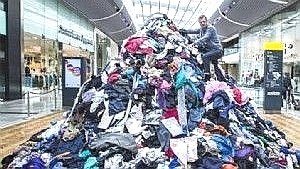Textile industry : The most polluting industry

Sky world news/ The textile industry is said to be the second most polluting industry in the world, just after oil. Behind this widely held observation today, however, it is difficult to find a reliable and unique figure.
According to studies, this varies greatly between 3 and 10% of global CO2 emissions.
second polluting textile industry But in the end, the exact number or the ranking does not matter: 3% is already too much.
And this is what we have to realize and understand.
To get to understand on our scale of consumers the order of magnitude that this figure represents, and to have a general idea of the mechanisms of this industry disparaged, but so anchored in our daily life.
To act better. The Ellen MacArthur Foundation's report A new textiles economy: Redesigning fashion's future thus indicates the figure of 1.2 billion tonnes of CO2 equivalent, more than the total emissions of international maritime and air transport combined.
What exactly does the environmental impact mean? When we talk about environmental impact, we must already understand what we are measuring: most of the results and figures that we read on this subject mainly concern the carbon footprint of the product: in fact today we consider that the emission of greenhouse gases is the main source that modifies the functioning of our environment and our planet.
The carbon footprint, given in kg of CO2 equivalent, is thus the amount of greenhouse gases released by the system studied. But many other factors can be studied: the consumption of fresh water or water provided by man, the energy used from fossil resources, the imbalance of aquatic environments following toxic discharges (eutrophication), the toxicological impact on the human.
All of these aspects together constitute the environmental impact. Why is the textile industry polluting, almost by nature? The latest report from the Ellen McArthur Foundation released at the end of 2017 sheds an uncompromising light on the textile industry today: from the extraction of non-renewable resources, to landfill or incineration without recycling, through a number of important washes during use, each step is very polluting.
But that's not all. The textile industry operates in a very linear fashion (I produce - I consumethrow away), which also generates a lot of high-impact waste, and it accumulates .
Material flow in mobile textiles A production almost exclusively from new materials, which ends up for 3/4 in landfill or incinerated. Ellen MacArthur Foundation, A new textiles economy: Redesigning fashion’s future Thus, 73% of the raw material finished in landfill or incinerated according to this study, and only 13% of the materials used to produce clothes are recycled at the end of their life .



